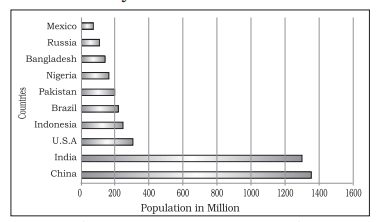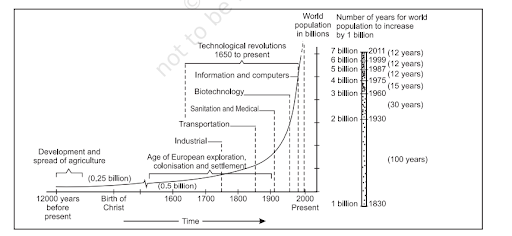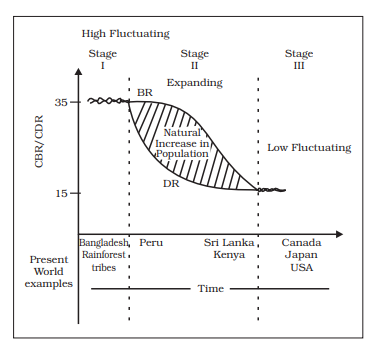The world population, its distribution, density and growth reflect the advancement and development of each geographical zone. The world population has a huge impact on the world economy and climate change.
Patterns of Population Distribution in the World
The term population distribution refers to the way people are spaced over the surface of the earth. Broadly, 90% of the world’s population lives in about 10% of the earth’s land area. The 10 most populous countries of the world contribute about 60% of the world’s population (the six countries out of the ten are located in Asia).

Image source-NCERT
Population Density
Population density is the ratio between the number of people to the area of the land. It is measured in persons per square kilometre or km². The densely populated parts of the world are the north-eastern part of the U.S.A, north-western part of Europe, south, south-east and east Asia. The thinly populated regions of the world are near the north and south poles, the hot and the cold deserts and high rainfall zones near the equator. The population density of India in 2011 was 382 per sq. km.
Density of population = Total Population / Total Area
Patterns of population distribution and density give the demographic characteristics of any area.
Factors influencing the distribution of population
The following factors affect the population distribution:
- Geographical factors
- Economic factors
- Social and cultural factors
Geographical Factors-
- Water availability – Water is the most essential factor for the existence of life. It is used for multiple purposes like cooking, drinking, agriculture, etc. People prefer to inhibit areas which have water in abundance, that is why river valleys are among the most densely populated areas of the world.
- Landforms – The Ganga Plains are among the most densely populated areas of the world while mountainous regions of the Himalayas are thinly populated. People prefer flat plains and gentler slopes which are favourable for agricultural purposes, to build better road connectivity and for industries.
- Climate – A climate which is neither too hot nor too cold attracts more people. Areas with very heavy rainfall or extreme and harsh climate have low population density.
- Soil – Areas with fertile, loamy soils are preferred by people as this type of soil supports intensive agriculture.
Economic Factors-
- Minerals -The regions with rich mineral deposits attract industries which in turn generate employment opportunities. People move to such places and make them thickly populated. For example, Katanga Zambia copper belt in Africa.
- Urbanisation – Urban centres offer better employment opportunities, educational and medical facilities, have better means of transport and communication. This results in rural to urban migration and cities become densely populated.
- Industrialisation – Industrial areas provide job opportunities thereby attracting a huge number of people. For example, the Kobe-Osaka region of Japan is densely populated due to the presence of a large number of industries.
Social and Cultural Factors-
Religious or cultural importance also affects the population density of a place. Such places attract more people and if there is social and political unrest in a region, people tend to move away from such places. Sometimes the government offers incentives to people to move to thinly populated areas or move away from overcrowded places.
Population Growth/Population Change
It refers to the change in the number of inhabitants of a territory over a specific period of time. Population growth is expressed either in terms of percentage or absolute numbers. It can be positive as well as negative. Population change indicates the economic development, social upliftment and historical and cultural background of the area.
Some Basic Concepts of Population Geography
- Growth of population – It is the change of population in a particular area between two points of time.
- Growth rate of population – When the change in population is expressed in terms of percentage, it is the growth rate of population.
- Natural growth of population – Natural Growth = Births – Deaths (It is the population increase by the difference between births and deaths in a particular region between two points of time).
- Actual growth of population – Actual Growth = Births – Deaths + In Migration – Out Migration.
- Positive growth of population – This happens when the birth rate is more than the death rate between two points of time or when people from other countries migrate permanently to a region.
- Negative growth of population – This happens when the population decreases between two points of time, either when the birth rate falls below the death rate or people migrate to other regions.
Components of Population Change
There are three components of population change – births, deaths and migration.
- Crude Birth Rate (CBR) – It is expressed as the number of live births in a year per thousand of the population.
 2. Crude Death Rate (CDR) – It is expressed in terms of the number of deaths in a particular year per thousand of population in a particular region. It is a simple method to measure the mortality of any area.
2. Crude Death Rate (CDR) – It is expressed in terms of the number of deaths in a particular year per thousand of population in a particular region. It is a simple method to measure the mortality of any area.

The region’s demographic structure, social advancement and economic development largely affect the mortality rates of that particular region.
3. Migration – The population size also changes by way of migration. Migration refers to the movement of people from one place to the other, the place they move from is called the place of origin and the place they move to is called the place of destination. Migration may be permanent, temporary or even seasonal. The people who move are called migrants. Migrants who move into a new place are called immigrants and migrants who move out of a place are called emigrants. The main purpose of migration is to attain better economic and social life.
Factors that influence migration-
- Push factors – The factors like poor living conditions, unemployment, unpleasant climate, political turmoil, epidemics, natural disasters and social-economic backwardness make the place of origin seem less attractive.
- Pull factors – The factors like better living conditions, job opportunities, peace and stability, security of life and property, and pleasant climate make the place of destination more attractive
Trends in Population Growth
During the early periods, the population of the world grew very slowly. The world population exploded in the 18th century after the Industrial Revolution. Technological developments helped in reducing the death rate thereby, paving the way for accelerated population growth.
The human population increased more than ten times in the past 500 years.
- In the 20th century itself, population growth has increased four times.

Image Source- NCERT
- The annual population growth rate in India is 1.64%.
Demographic Transition
It is a theory which is used to represent the movement of high birth and death rates as the society progresses from rural agrarian and illiterate to urban industrial and literate society. It studies the relationship between economic development and population growth. This theory can be used to describe and predict the future population of any area. These changes occur in stages which are collectively called a demographic cycle.
- Stage 1 – The first stage is characterised by high birth and death rates, and therefore, population growth is slow. This stage is associated with under-developed, low output and agriculture-dominated conditions. Two hundred years ago, all the countries of the world were in the first stage of demographic transition.
- Stage 2 – It is characterised by a high birth rate and reduced mortality rate leading to an increased population. Improvements in medical care, water supply and sanitation result in decreased death rates.
- Stage 3 – In this stage both birth and death rate decline appreciably. The population is either stable or grows slowly. The population becomes urbanised, literate and has a high technical know-how and controls the family size.
In the present times, different countries are at different stages of demographic transition.

Image Source NCERT
_____________________________________






0 Comments